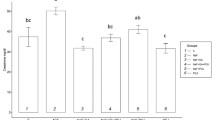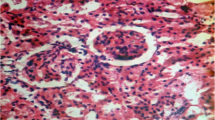Abstract
The purpose of this study was to evaluate the effect of pomegranate (Punica granatum) in inhibiting and reversing the nephrotoxicity of carbon tetrachloride, a potent oxidative stress inducer which induces cellular kidney damage. Rats were intraperitoneally injected with carbon tetrachloride (2 mL/kg body weight) which produced severe renal tissue damage, as demonstrated by decreased uric acid and dramatic elevation of urea and creatinine. In addition, carbon tetrachloride injection caused oxidative stress in rats, as evidenced by increased lipid peroxidation and nitrite/nitrate (NO x ) concentrations in the renal tissue, along with a remarkable reduction in superoxide dismutase, catalase, glutathione transferase, glutathione reductase, glutathione peroxidase activities and glutathione content. We suggested that pomegranate juice was able to elevate the antioxidant defense system, clean up free radicals, lessen oxidative damages and protect the kidney against carbon tetrachloride-induced toxicity, thus having a potential protective effect.





Similar content being viewed by others
References
Abdel Moneim AE, Dkhil MA, Al-Quraishy S (2011) The protective effect of flaxseed oil on lead acetate-induced renal toxicity in rats. J Hazard Mater 194:250–255
Aebi H (1984) Catalase in vitro. Methods Enzymol 105:121–126
Afaq F, Saleem M, Krueger CG, Reed JD, Mukhtar H (2005) Anthocyanin- and hydrolyzable tannin-rich pomegranate fruit extract modulates MAPK and NF-kappaB pathways and inhibits skin tumorigenesis in CD-1 mice. Int J Cancer 113(3):423–433
Akca T, Canbaz H, Tataroglu C, Caglikulekci M, Tamer L, Colak T, Kanik A, Bilgin O, Aydin S (2005) The effect of n-acetylcysteine on pulmonary lipid peroxidation and tissue damage. J Surg Res 129(1):38–45
Al-Shabanah OA, Alam K, Nagi MN, Al-Rikabi AC, Al-Bekairi AM (2000) Protective effect of aminoguanidine, a nitric oxide synthase inhibitor, against carbon tetrachloride induced hepatotoxicity in mice. Life Sci 66(3):265–270
Aviram M, Dornfeld L, Rosenblat M, Volkova N, Kaplan M, Coleman R, Hayek T, Presser D, Fuhrman B (2000) Pomegranate juice consumption reduces oxidative stress, atherogenic modifications to LDL, and platelet aggregation: studies in humans and in atherosclerotic apolipoprotein E-deficient mice. Am J Clin Nutr 71(5):1062–1076
Aydogan S, Yapislar H, Artis S, Aydogan B (2008) Impaired erythrocytes deformability in H(2)O(2)-induced oxidative stress: protective effect of l-carnosine. Clin Hemorheol Microcirc 39(1–4):93–98
Bachoual R, Talmoudi W, Boussetta T, Braut F, El-Benna J (2011) An aqueous pomegranate peel extract inhibits neutrophil myeloperoxidase in vitro and attenuates lung inflammation in mice. Food Chem Toxicol 49(6):1224–1228
Bashkatova V, Alam M, Vanin A, Schmidt WJ (2004) Chronic administration of rotenone increases levels of nitric oxide and lipid peroxidation products in rat brain. Exp Neurol 186(2):235–241
Berkels R, Purol-Schnabel S, Roesen R (2004) Measurement of nitric oxide by reconversion of nitrate/nitrite to NO. Methods Mol Biol 279:1–8
Burits M, Bucar F (2000) Antioxidant activity of Nigella sativa essential oil. Phytother Res 14(5):323–328
Chidambara Murthy KN, Jayaprakasha GK, Singh RP (2002) Studies on antioxidant activity of pomegranate (Punica granatum) peel extract using in vivo models. J Agric Food Chem 50(17):4791–4795
Dewanto V, Wu X, Liu RH (2002) Processed sweet corn has higher antioxidant activity. J Agric Food Chem 50(17):4959–4964
Drury RAD, Wallington EA (1981) Carleton’s histological technique. Oxford University Press, New York
Ellman GL (1959) Tissue sulfhydryl groups. Arch Biochem Biophys 82(1):70–77
Factor VM, Kiss A, Woitach JT, Wirth PJ, Thorgeirsson SS (1998) Disruption of redox homeostasis in the transforming growth factor-alpha/c-myc transgenic mouse model of accelerated hepatocarcinogenesis. J Biol Chem 273(25):15846–15853
Faria A, Monteiro R, Mateus N, Azevedo I, Calhau C (2007) Effect of pomegranate (Punica granatum) juice intake on hepatic oxidative stress. Eur J Nutr 46(5):271–278
Garratt CJ (1964) Effect of iodination on the biological activity of insulin. Nature 201(4926):1324–1325
Habig WH, Pabst MJ, Jakoby WB (1974) Glutathione S-transferases. The first enzymatic step in mercapturic acid formation. J Biol Chem 249(22):7130–7139
Halliwell B (1994) Free radicals, antioxidants, and human disease: curiosity, cause, or consequence? Lancet 344(8924):721–724
Ichikawa I, Kiyama S, Yoshioka T (1994) Renal antioxidant enzymes: their regulation and function. Kidney Int 45(1):1–9
Jamshidzadeh A, Baghban M, Azarpira N, Mohammadi Bardbori A, Niknahad H (2008) Effects of tomato extract on oxidative stress induced toxicity in different organs of rats. Food Chem Toxicol 46(12):3612–3615
Janero DR (1990) Malondialdehyde and thiobarbituric acid-reactivity as diagnostic indices of lipid peroxidation and peroxidative tissue injury. Free Radic Biol Med 9(6):515–540
Kaviarasan S, Naik GH, Gangabhagirathi R, Anuradha CV, Priyadarsini KI (2007) In vitro studies on antiradical and antioxidant activities of fenugreek (Trigonella foenum graecum) seeds. Food Chem 103(1):31–37
Khan MR, Rizvi W, Khan GN, Khan RA, Shaheen S (2009) Carbon tetrachloride-induced nephrotoxicity in rats: protective role of Digera muricata. J Ethnopharmacol 122(1):91–99
Khan RA, Khan MR, Sahreen S, Bokhari J (2010) Prevention of CCl4-induced nephrotoxicity with Sonchus asper in rat. Food Chem Toxicol 48(8–9):2469–2476
Kim DO, Chun OK, Kim YJ, Moon HY, Lee CY (2003) Quantification of polyphenolics and their antioxidant capacity in fresh plums. J Agric Food Chem 51(22):6509–6515
Lansky EP, Newman RA (2007) Punica granatum (pomegranate) and its potential for prevention and treatment of inflammation and cancer. J Ethnopharmacol 109(2):177–206
Levin W, Lu AY, Jacobson M, Kuntzman R, Poyer JL, McCay PB (1973) Lipid peroxidation and the degradation of cytochrome P-450 heme. Arch Biochem Biophys 158(2):842–852
Li Y, Guo C, Yang J, Wei J, Xu J, Cheng S (2006) Evaluation of antioxidant properties of pomegranate peel extract in comparison with pomegranate pulp extract. Food Chem 96(2):254–260
Manna P, Bhattacharyya S, Das J, Ghosh J, Sil P (2011) Phytomedicinal role of Pithecellobium dulce against CCl4-mediated hepatic oxidative impairments and necrotic cell death. Evid Based Complement Alternat Med 17 pp
Molina MF, Sanchez-Reus I, Iglesias I, Benedi J (2003) Quercetin, a flavonoid antioxidant, prevents and protects against ethanol-induced oxidative stress in mouse liver. Biol Pharm Bull 26(10):1398–1402
Mustafa RA, Hamid AA, Mohamed S, Bakar FA (2010) Total phenolic compounds, flavonoids, and radical scavenging activity of 21 selected tropical plants. J Food Sci 75(1):C28–C35
Negi PS, Jayaprakasha GK, Jena BS (2003) Antioxidant and antimutagenic activities of pomegranate peel extracts. Food Chem 80(3):393–397
Nishikimi M, Appaji N, Yagi K (1972) The occurrence of superoxide anion in the reaction of reduced phenazine methosulfate and molecular oxygen. Biochem Biophys Res Commun 46(2):849–854
Ohkawa H, Ohishi N, Yagi K (1979) Assay for lipid peroxides in animal tissues by thiobarbituric acid reaction. Anal Biochem 95(2):351–358
Oyaizu M (1986) Studies on products of browning reaction: antioxidative activities of products of browning reaction prepared from glucosamine. Japanese J Nutr 44:307–315
Ozgocmen S, Kaya H, Fadillioglu E, Aydogan R, Yilmaz Z (2007) Role of antioxidant systems, lipid peroxidation, and nitric oxide in postmenopausal osteoporosis. Mol Cell Biochem 295(1–2):45–52
Pacher P, Beckman JS, Liaudet L (2007) Nitric oxide and peroxynitrite in health and disease. Physiol Rev 87(1):315–424
Paglia DE, Valentine WN (1967) Studies on the quantitative and qualitative characterization of erythrocyte glutathione peroxidase. J Lab Clin Med 70(1):158–169
Rosenblat M, Hayek T, Aviram M (2006) Anti-oxidative effects of pomegranate juice (PJ) consumption by diabetic patients on serum and on macrophages. Atherosclerosis 187(2):363–371
Sahreen S, Khan MR, Khan RA (2011) Estimation of flavonoids and evaluation of protective effect of Carissa opaca Stapf ex Haines fruit against CCl(4) induced nephrotoxicity in rat. Food Chem Toxicol (withdrawn article in press)
Samouilidou EC, Grapsa EJ, Kakavas I, Lagouranis A, Agrogiannis B (2003) Oxidative stress markers and C-reactive protein in end-stage renal failure patients on dialysis. Int Urol Nephrol 35(3):393–397
Scharf G, Prustomersky S, Knasmuller S, Schulte-Hermann R, Huber WW (2003) Enhancement of glutathione and g-glutamylcysteine synthetase, the rate limiting enzyme of glutathione synthesis, by chemoprotective plant-derived food and beverage components in the human hepatoma cell line Hep G2. Nutr Cancer 45(1):74–83
Schubert SY, Lansky EP, Neeman I (1999) Antioxidant and eicosanoid enzyme inhibition properties of pomegranate seed oil and fermented juice flavonoids. J Ethnopharmacol 66(1):11–17
Sohn DH, Yun YP, Park KS, Veech RL, Song BJ (1991) Post-translational reduction of cytochrome P450IIE by CCl4, its substrate. Biochem Biophys Res Commun 179(1):449–454
Sonmez M, Turk G, Yuce A (2005) The effect of ascorbic acid supplementation on sperm quality, lipid peroxidation and testosterone levels of male Wistar rats. Theriogenol 63(7):2063–2072
Talalay P, Fahey JW, Holtzclaw WD, Prestera T, Zhang Y (1995) Chemoprotection against cancer by phase 2 enzyme induction. Toxicol Lett 82–83:173–179
Tripathi YB, Sharma M (1998) Comparison of the antioxidant action of the alcoholic extract of Rubia cordifolia with Rubia din. Indian J Biochem Biophys 35(5):313–316
Turk G, Sonmez M, Aydin M, Yuce A, Gur S, Yuksel M, Aksu EH, Aksoy H (2008) Effects of pomegranate juice consumption on sperm quality, spermatogenic cell density, antioxidant activity and testosterone level in male rats. Clin Nutr 27(2):289–296
Valadares MC, Pereira ERT, Benfica PL, Paula JR (2010) Assessment of mutagenic and antimutagenic effects of Punica granatum in mice. Braz J Pharm Sci 46:121–127
Yehia HM, Elkhadragy MF, Abdel Moneim AE (2011) Antimicrobial activity of pomegranate rind peel extracts. Afr J Micro Res 4(22):3664–3668
Yuan LP, Chen FH, Ling L, Bo H, Chen ZW, Li F, Zhong MM, Xia LJ (2008) Protective effects of total flavonoids of Bidens bipinnata L. against carbon tetrachloride-induced liver fibrosis in rats. J Pharm Pharmacol 60(10):1393–1402
Author information
Authors and Affiliations
Corresponding author
Rights and permissions
About this article
Cite this article
Abdel Moneim, A.E., El-Khadragy, M.F. The potential effects of pomegranate (Punica granatum) juice on carbon tetrachloride-induced nephrotoxicity in rats. J Physiol Biochem 69, 359–370 (2013). https://doi.org/10.1007/s13105-012-0218-3
Received:
Accepted:
Published:
Issue Date:
DOI: https://doi.org/10.1007/s13105-012-0218-3




